TRAINING REPORT

CONSTRUCTION OF ASPHALT PAVEMENT BY PWD
Submitted byAkeel Javid
163224051007
Polytechnic III Year, V Sem., S.C.E.T.


Submitted byAkeel Javid
163224051007
Polytechnic III Year, V Sem., S.C.E.T.
Serial – 2/ExecutiveEngineer Date – 01/08/18
ItiscertifiedthatAkeelJavids/oMr.K.M.J.ShafanAli,studentofpolytechnic department of Sanskar Educational Group has received technical training from12/06/18to20/07/18underVIIsubdivisionassistantengineer. This certificate is being issued under these conditions that on the basis of thiscertificate,theapplicantwillnotbeconsideredforanypurposeinany claimdepartmentorintheappointmentofthePublicServiceCommissionin UttarPradesh.
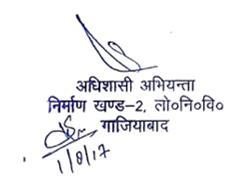
I would like to express the deepest appreciation to my Prof. Gajender Singh, who was also my guide through this training. He has the attitude and the substance of a genius; he continually and convincingly conveyed a spirit of adventure regarding the training, and an excitement regarding teaching. Without his guidance and persistent help, this training dissertation/report would not have been possible.
I would like to thank Mr. Anil and Mrs. Vartika from PWD, who were very cooperative with me and helped me obtain the permission to complete my training. Also, a thank you to Mr. Rahul of PWD, who helped me with the site visit. In addition, a big thank you to junior engineer Mr. Gulab Singh of PWD, who was very patient and guided me through the entire site and thoroughly explained the construction details, techniques and process of asphalt pavement and about the materials used in its construction.
I am very grateful to Sanskar College of Engineering and Technology for giving me the opportunity to do this training.
Last, but not the least, I appreciate all the support that my family members and my friends bestowed upon me. I would be forever grateful for all your love.
A road is a thoroughfare, route, or way on land between two places, which has been paved or otherwise improved to allow travel by some conveyance, including a horse, cart, or motor vehicle. Roads consist of one, or sometimes two, roadways (carriageways) each with one or more lanes and any associated sidewalks (British English: pavement) and road verges. Roads that are available for use by the public may be referred to as public roads or highways.
Everyone is aware about the benefits and advantages of a good constructed road. Roads play very crucial role in modern society providing services and goods for modern people. Today a clear majority of road are constructed using Asphalt. Now question arises in your mind is “What is Asphalt”? Asphalt is the sticky dark brown viscous liquid present in some natural deposits like crude petroleum. It is the name given to technically or natural mixture used in road construction for road surfacing and compaction.
We see many roads daily and when we talk about the road construction, all are equally constructed but there is a difference arising in the finishing of the road or the surface material used for finishing. Asphalt, also known as bitumen concrete in engineering language is used to give flexible surface to roads. Asphalt road offers many benefits such as smooth and flexible surface including cost efficiency, improved safety and comfort, durability, recyclability and reduction in noise pollution. Sometimes Asphalt or bitumen are confused with tar. Although they are same in colour, they have distinct chemical properties. Tar was early used in road Asphalt, but now has been replaced by refined bitumen or Asphalt. Today Asphalt is more commonly produced as a by-product of the refining process in the petroleum industry.
Road construction is not as easy as it seems to be, it includes various steps and it starts with its designing and structure including the traffic volume consideration. Then base layer is done by bulldozers and levellers and after base surface coating must be done. For giving the road a smooth surface with flexibility, Asphalt concrete is used. Asphalt requires an aggregate sub base material layer, and then a base layer to be put into first place. Asphalt road construction is formulated to support the heavy traffic load and climatic conditions. It is 100% recyclable and saving nonrenewable natural resources.
With the advancement of technology, Asphalt technology gives assurance about the good drainage system and with skid resistance it can be used where safety is necessary such as outside the schools.
The largest use of Asphalt is for making asphalt concrete for road surfaces. It is widely used in airports around the world due to the sturdiness and ability to be repaired quickly, it is widely used for runways dedicated to aircraft landing and taking off. Asphalt is normally stored and transported at 150’C or 300’F temperature.
The Public Works Department was a government department that was responsible for buildings, roads, irrigation and railways.
Public Works in India, such as the construction of roads, water tank, etc. was originally conducted by the military. This started with the Pioneers and then by the Public Works Department of the Town Major's List (Bengal & Bombay) or the Effective Supernumeraries (Madras). Much of the responsibility for public works was then passed over to a special section of the Indian Civil Service in the mid-19th century. Later, the military once more took responsibility for much of the public works.
Drawing attention of the Government to the unsatisfactory management and in public works, the Court of Directors of the East India Company, in early 1850, instituted a Commission in each Presidency for investigation. The members of the Commission were unanimous on the inability of the Military Board in the management of public works. Lord Dalhousie founded the Public Works Department (PWD) through which roads, railways, bridges, irrigation and other public utility works were undertaken.
The Commission proposal, which was implemented in 1854, set out the following basic features: -
• The Control of PWD was removed from under the Military Board and placed under the Chief Engineers.
• The PWD came under the control of respective provincial Government.
• Chief Engineers to be assisted by the Superintending Engineer & Executive Engineer.
3.1
Dark brown to black, thick, viscous mixture of heavy hydrocarbons that occurs naturally (left after evaporation of lighter hydrocarbons, as in Trinidad's Pitch Lake) or as a residue of crude oil refining or destructive distillation of coal. Its ability to flow when heated, moisture repellence, and (depending on the type of additive) a range of softening points (usually between 57°C to 99°C, or about 135°F to 210°F) makes it an ideal material for road paving, roofing, and water proofing applications. Also called bitumen, coal tar, pitch, or tar.
Bitumen is the liquid binder that holds asphalt together. The term bitumen is often mistakenly used to describe asphalt.
A bitumen-sealed road has a layer of bitumen sprayed and then covered with an aggregate. This is then repeated to give a two-coat seal.
Asphalt is produced in a plant that heats, dries and mixes aggregate, bitumen and sand into a composite mix. It is then applied through a paving machine on site as a solid material at a nominated or required thickness, relative to the end use. Asphalt results in a smoother and more durable surface than a bitumen-sealed road.
3.3
Pavement, in civil engineering is a durable surfacing of a road, airstrip, or similar area. The primary function of a pavement is to transmit loads to the sub-base and underlying soil. Modern flexible pavements contain sand and gravel, or crushed stone compacted with a binder of bituminous material, such as asphalt, tar, or asphaltic oil. Such a pavement has enough plasticity to absorb shock. Rigid pavements are made of concrete, composed of coarse and fine aggregate and Portland cement, and usually reinforced with steel rod or mesh.
3.4 ASPHALT PAVEMENT
Asphalt pavement refers to any paved road surfaced with asphalt. Hot Mix Asphalt (HMA) is a combination of approximately 95% stone, sand, or gravel bound together by asphalt cement, a product of crude oil. Asphalt cement is heated aggregate, combined, and mixed with the aggregate at an HMA facility. The resulting Hot Mix Asphalt is loaded into trucks for transport to the paving site. The trucks dump the Hot Mix Asphalt into hoppers located at the front of paving machines. The asphalt is placed, and then compacted using a heavy roller, which is driven over the asphalt. Traffic is generally permitted on the pavement as soon as the pavement has cooled.
The sub grade is the layer of naturally occurring material or the fill material the road is built upon. The strength of the subgrade layer is measured using the CBR test. The strength of the subgrade layer is an important factor influencing the thickness of the road pavement design. Where the subgrade is weak, i.e. a low CBR, a capping layer will be necessary over the subgrade to increase the actual road pavement thickness to be designed.
When the California Bearing Ratio (CBR) of the sub grade is less than 5 %, it is general to form a suitable capping layer of low-cost material. This capping layer is usually a granular type material designed to provide a working platform on which sub-grade construction can proceed with minimum interruption from wet weather.
The primary function of sub base layer is to improve drainage, minimize frost action damage, provide a working platform for construction.
The material used in this layer:
1.Granular Sub base (GSB)
2.Cement bound material
GSB Type-1: This material is typically crushed stone, crushed slag, crushed concrete or non-plastic well-burnt shale.
GSB Type-2: It is a much finer material, has a much wider grading envelope and is of a lesser “engineering” quality than GSB Type -1. Therefore, it does not generate much interlocking as a type 1 and is consequently not a strong one.
The road base is the main load-bearing layer. In road structure usually 100 mm or thicker layer is built depending upon the load of the traffic for which the road is designed. The road base is usually a bituminous material, dense bitumen macadam (asphalt concrete) or hot rolled asphalt.
This is the layer below the surface course and above road base. The base course (binder course) is a load transmitting layer, transmitting the load imposed on the wearing course (surface course) over a wider area of the road base. Base course (binder course) is most commonly a bituminous material, can be either hot rolled

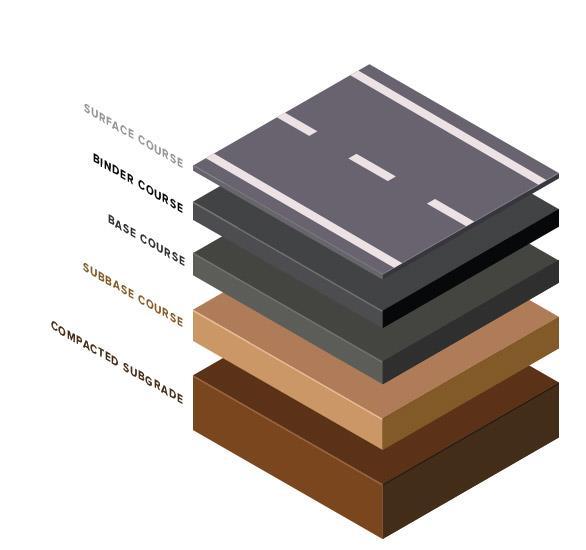
asphalt or dense bitumen Macadam (asphalt concrete). This is a strengthening layer of the pavement and should be at least 40 mm thick, preferably 50 mm thick.
The wearing course is the topmost layer of the road pavement and is designed to be impervious to the ingress(entering) of water, to have an even running surface, to be durable, to have a high resistance to skidding and not to deform due to the load of traffic.
1. SOAL COAT - It is a thin surface treatment used to water proof the surface and to provide skid resistance.
2. TACK COAT - It is very light application of asphalt, usually asphalt emulsion diluted with water to provide proper bonding between the two layer of binder course and must be thin uniformly covering the entire surface and must set very fast.
3. PRIME COAT - It is an application of low viscous cutback bitumen to an absorbent surface like granular bases on which binder layer is placed. Unlike tack coat, prime coat penetrates the layer below, plugs the voids, and forms a water tight surface.
Pavement Material Asphalt and concrete are the most common paving materials found in the developed landscape. However, there are other strong, durable pavements that can add variety to the built landscape and help reduce pavement's imperviousness.
Bituminous concrete or asphalt is composed of aggregates bound together with asphalt cement. The aggregate is heated and mixed with hot (275º f) asphalt then taken to the construction site where it is placed, as a wearing surface, over a base course. The asphalt is laid by hand and paving machine, then rolled to force the mixture to firmly set. It is then allowed to cool; typical asphalt pavement has a life expectancy of 20 years before it needs resurfacing. Asphalt pavement is composed of the following two layers, the wearing course and the base course. The Wearing Course transfers and distributes traffic loads to the base course. The wearing course is composed of two layers, a 1-1/4" to 1-1/2" surface layer and a 3" bonding layer. The bonding course penetrates voids in the sub base and binds the wearing course to the sub base aggregate.
Stone is a durable paving surface that is available in either natural or synthetic form. Natural paving stone is graded based on its' hardness, porosity and abrasion resistance. It is available either in cut or uncut form in various degrees of smoothness. Examples of uncut or rubble stone, are broken quarry rock and river stone available in varying degrees of smoothness. Crushed stone of various sizes and hardness is used as sub-base for other surface materials, surface pavement or ground cover. When mixed with asphalt or concrete, crushed stone or aggregate is used in the wearing and base course of roads, drives, parking lots and sidewalks. Larger stones are mixed with asphalt or concrete when a rougher or more porous surface is desired.
Earth materials used for paving include gravel, soil, granular products, and turf. The volume of earth materials is determined by its state in the earth moving process.
For example: a cubic yard of gravel as it lies in its natural, undisturbed state usually swells to 1.25 cubic yards after it has been disturbed by excavation. The same quantity of gravel decreases in volume to about .90 cubic yards after it has been compacted by machinery on site.
Procedure
1. Measure the internal dimensions (diameter, d and height, h) of the calibrating can and compute its internal volume, Vc = πd2h/4.
2. Find the weight of the SPC along with the sand remaining after filling the cone (W2)
3. Place the SPC concentrically on top of the calibrating can. Open the slit to allow the sand to run down until the sand flow stops by itself. This operation will fill the calibrating can and the conical portion of the SPC. Now close the slit and find the weight of the SPC with the remaining sand (W3)
4. Clean and level the ground surface where the field density is to be determined.
5. Place the tray with a central hole over the portion of the soil to be tested.
6. Excavate a pit into the ground, through the hole in the plate, approximately 12 cm deep (same as the height of the calibrating can). The hole in the tray will guide the diameter of the pit to be made in the ground.
7. Collect the excavated soil into the tray and weigh the soil (W).
8. Determine the moisture content of the excavated soil.
9. Place the SPC, with sand having the latest weight of W3, over the pit so that the base of the cylinder covers the pit concentrically.
10. Open the slit of the SPC and allow the sand to run into the pit freely, till there is no downward movement of sand level in the SPC and then close the slit.
11. Find the weight of the SPC with the remaining sand (W4)
OBSERVATION TABLE
S.No. Description Trail
1. Weight of wet material from hole, Ww (g) 1445
2. Weight of cylinder + sand (before pouring), W1(g) 6700
3. Weight of cylinder + sand, W2(g) (after pouring) 5369
4. Weight of sand in cone, W3 330
5. Weight of sand in hole W4=W1 –W2-W3 (g) 1001
6. Volume of test hole =W4 X γs 738.2
7. Bulk density of material γb=Ww/W4 1.957
8. Field dry density 1.882
9. Compaction obtained 97.83%
10. Percentage compaction required as per specification 95%
11. Moisture content 4%


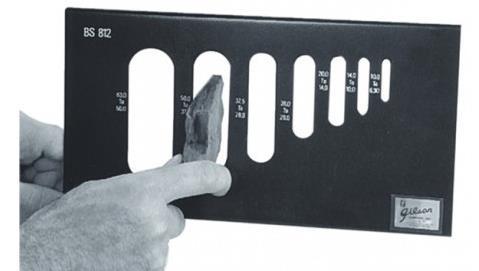

Test Sample Preparation - Surface dry samples are used for the test. A minimum number of 200 pieces of any specified fraction is required to do the test.
1. A minimum of 200 pieces of each fraction is taken and weighed.
2. To separate elongated materials, each fraction is then gauged individually for length in the length gauge.
3. The pieces of aggregate from each fraction tested which could not pass through the specified gauge length with its long sides elongated are collected separately to find the total weight of aggregate retained on the length gauge from each fraction.
4. The total amount of elongated material retained by the length gauge is weighed to an accuracy of 0.1% of the weight of sample.
To calculate the elongation index of the entire sample of aggregates, first the weight of each fraction of aggregate passing and retained on the specified set of sieves is noted (Y1, Y2, Y3, Y4…. etc). Each piece of these are tried to be passed through specified length of the gauge length with its longest side and those elongated pieces which do not pass the gauge are separated and weighed (y1, y2, y3, y4…etc). Then
the elongated index is the total weight of the material retained on the various length gauges, expressed as a percentage of the total weight of the sample gauged.

The sample is sieved through IS sieve specified in Table shown below.
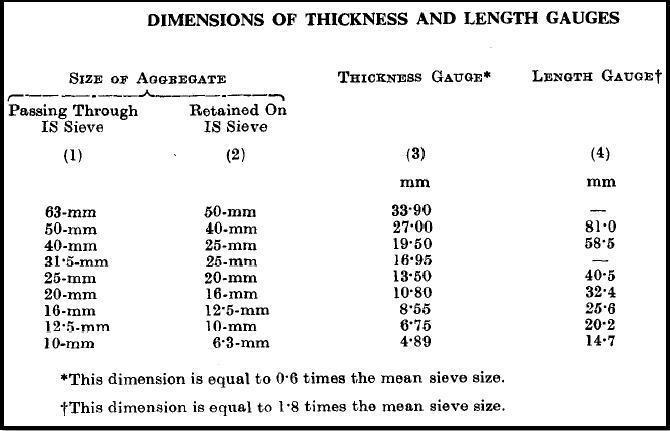
Reports
Flakiness index is reported in percentage to the nearest whole number=39%.
Procedure
1. We took a fresh sample from a loaded truck of 40Kg.
2. Took 3 samples.
3. Weigh tissue paper and put sample-1 into pan and add enough benzene.
4. Weigh the sample and pan.
5. Benzene is mixed with sample using spatula and tissue paper were putted over pan.
6. Now pan was put into Bitumen Extractor Machine.
7. Run the machine until benzene stop running out of pan.
8. Step 5-7 were repeated two more times.
9. Weight the pan & tissue paper.
OBSERVATION TABLE
S.No. Description 1 2 3
1. Weight of sample test, W1
2. Weight of sample after test, W2
3. Weight of tissue paper before test, W3
4. Weight of tissue paper after test, W4
5. Increased weight of tissue paper, W4-W3
6. Weight of bitumen, W5=W1(W2+W4-W3)
7. Bitumen content of mix, (W5/W1) x100 %
8. Specific limits (%)
• Before any construction the roadway must be cleared of all vegetation and trees including their roots removed.
• Cross sections should be taken prior to any excavation works.
• All construction works must be carried out in as safe a manner as possible.
• Excavated suitable materials should be used when possible in the works.
• Provision must be made for drainage of the temporary and permanent works.
• Soil containing vegetable matter is not suitable as fill material.
• Borrow pits should not affect the stability of the road, or any other structure.
• All fill materials must be free from vegetable matter and the material must be approved as suitable.
• The material should be of an appropriate nature and at a moisture content that it can be compacted to form a stable layer.
• Generally, embankments should be constructed in 150 mm compacted layers parallel to the finished grade of the road.
• For each completed layer the density should be checked (One test for each 1,000 square metres) by laboratory personnel. If test results show the required density is not achieved further compaction is necessary.
• Any soft areas must be rectified before further material is placed. Each earthworks layer requires to be approved before the next layer can be started.
• All subgrade material must be free from vegetable matter.
• The subgrade must be shaped to the required profile.
• The subgrade should be of an appropriate material and at a moisture content that it can be compacted to form a stable layer, for the full width of the embankment.
• Three tests to check the compaction for each 1,000 square metres should be completed. If the results show the required density is not achieved further compaction is necessary.
• When specified, subgrade drains should be constructed to the edge of the embankment.
• The compacted subgrade layer requires to be approved with any soft areas being rectified, before work can start on the pavement.
• At least seven days before a proposed material's, use a sample of the material along with laboratory test results must be submitted by the contractor to the Engineer for approval. Fresh approval is required if the material is changed.
• The material for sub base and base must be graded, with enough fines that they can be properly compacted. All areas of segregated coarse or fine material must be corrected or removed and replaced with complying material.
• Continued checks on materials must be carried out throughout the contract period. If the materials’ tests indicate changes have occurred the contractor and the Engineer must be immediately informed.
• The moisture content of the material at the time of compaction must be appropriate to produce a dense compacted layer.
• If a pavement layer, does not conform with the thickness or tolerance required, the layer must be corrected. Once the correction is completed the area should be rechecked to ensure it conforms to the correct depth, cross fall and degree of compaction.
• Each layer should be tested for compaction (3 tests for each 1000 square metres). If the test results show that the required density is not achieved, further compaction must be undertaken. · Each layer of pavement must be shaped, compacted and approved ahead of the placing of subsequent material.
• At least 14 days in advance of a proposed material’s use, samples of the material along with laboratory test results should be submitted to the Engineer. If approved, the contractor should then carry out trial mixes.
• The surface upon which the bitumen or bituminous mixture is to be placed must be thoroughly cleaned immediately before the bitumen or mixture is placed.
• Bituminous materials should be placed only when the surface is dry, when rain does not appear imminent and when the prepared roadbed is in a satisfactory condition.
• The entire surface to be primed must be covered evenly. Prior to any spraying, the nozzles on the spray bar of the distributor should be checked to ensure that they are all working. Where appropriate the distributor should be calibrated to ensure the required rate of spray is achieved. Depending on the nature of the surface to be primed a light application of water just prior to priming may be beneficial to aid penetration of the bituminous material.
• No bituminous mixtures should be placed until the prime coat has dried. · Tack coat may need to be applied to make the road surface sticky prior to the bituminous carpeting layer being placed.
• For Primer Seals and Bitumen Surface Treatments the aggregate must be spread and rolled into bitumen immediately after spraying, preferably rolling should be by multi tyre rollers.
8.1 Clearing and Grubbing
Before any construction starts the roadway must be cleared of debris. Unless there are specific reasons, agreed to by the Engineer in writing, all materials including trees, grass, crops and structures, which fall within the road alignment must be removed. Also, all major stumps and roots need to be removed (grubbed out) and the holes left must be filled with compacted suitable fill material.
The following figure shows an example of the clearing and grubbing which is required.
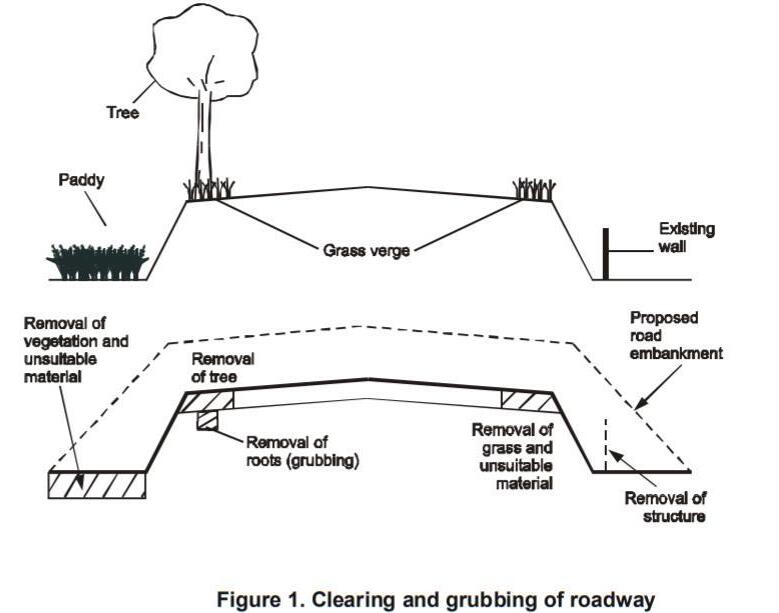
8.2 EXCAVATION
8.2.1 GENERAL
Before any excavation, including the removal of any areas of unsuitable materials, cross-sections should be taken of the undisturbed ground. From this information, and the cross sections taken of the completed road, earthwork quantities can be calculated.
No existing material, which will remain in the completed works, should be loosened unnecessarily during excavation.
Excavation works, along with all construction activities, must be undertaken in manner as safe as possible to minimise the dangers to road users and the contractor personnel.
8.2.2
Excavated materials need assessing as suitable or unsuitable. Suitable materials should be used when possible in the works. The excavated materials can be temporarily stockpiled, but must cause no damage to roads, services or property and not prevent water draining from the road or from the surrounding land.
Any excess suitable material, which is not required for the construction of the Works or any material classified as unsuitable is the property of RHD. The Contractor should stockpile these materials separately, as directed, or place the material in an approved location on site. To be suitable as fill material the soil must not contain any vegetable matter. To be suitable as road pavement the requirements for sub base or base materials must be met. Materials excavated from existing road pavements may meet the necessary requirements directly, or after breaking and mixing with other materials.
8.2.3
During construction, ditches are always required to be maintained to ensure proper drainage. Any necessary ditches and channels should be constructed and maintained to ensure there is no damage to the roadway section. All existing ditches, or drainage channels, which the road crosses, need to be closed at the edge of the embankment, unless pipes or structures are to be constructed and, where necessary, alternative outfalls are to be provided.
Any canals and channels which are located within the embankment area need to be cleaned up and then back filled with sand. The sand fill should reach a level of 500 mm above the water level.
8.2.4
The borrow pits should be kept as drained as possible. Borrow pits should not be constructed where they might:
a) Affect the stability or safety of the highway, or any railway or other structures, which may be present.
b) Prevent natural or artificial drainage or irrigation.
c) Damage adjacent property or future expansion plans for the highway. As materials are only paid for when included in the embankment, there is no need to measure the volume of material removed from any borrow pits.
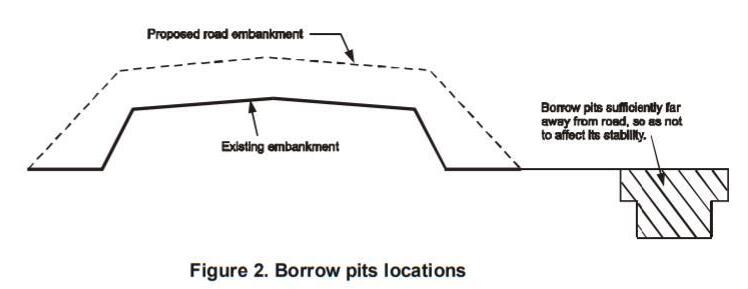
Before placing any material, clearing and grubbing and the removal of any unsuitable materials needs to have been completed. Also, any necessary information to determine earthwork quantities should have been collected (normally cross sections of the original ground).
Where an existing embankment is widened, the new fill material must be fully keyed into the old embankment by means of benching. Steps not less than 300 mm high and 600 mm wide should be cut into the old embankment prior to any filling. Material cut from these benches may be used as fill, if it is suitable.
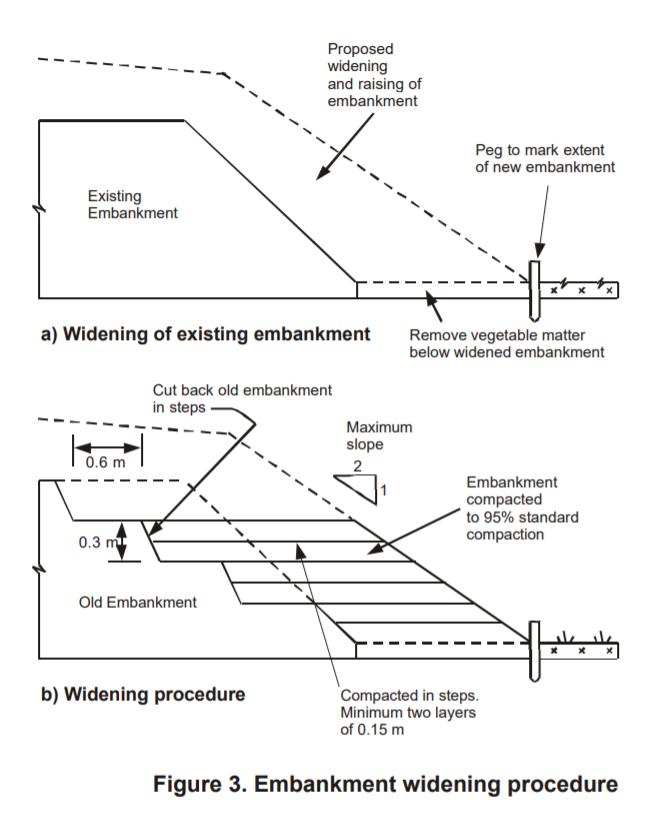
Normally embankments should be constructed in layers approximately parallel to the finished grade of the road. The grade and cross fall should be maintained during construction, as this will enable water to run off the embankment allowing construction work to start as soon as possible after rainfall and avoid soft spots forming.
All fill material used must be free from roots, or any vegetable matter. Each layer of fill should be less than 150 mm on completion of the compaction. Compaction must be undertaken using appropriate equipment. If large rollers (very heavy vibrating compaction) are used it may be possible to increase the depth of the layers, but this should only occur after checking that adequate compaction is being achieved. Generally, the compaction should begin at the outer embankment edges and gradually progress toward the centre rolling in a longitudinal direction so that the full width is uniformly compacted. To ensure proper compaction of the embankment slope it is good practice to overfill by 150 – 300 mm and then trim the embankment to the specified shape. The arisings can be re-used as fill material.
The fill material needs to be of a type and moisture content so that it can be compacted to form stable layers. The water content of each layer, before being compacted, must be assessed. The material may require water to be added or be allowed to dry to bring the moisture content close to the optimum to make it possible to achieve the required dry density and hence degree of compaction.
Normally one density test for each 1,000 square metres of every layer should be carried out by laboratory personnel. These tests should be carried out at random and be across the full width of the embankment. If the test results show that the density is less than that required, then further compaction to obtain at least the required density is necessary. Results of all the compaction tests undertaken should be kept on file.
If it is not possible to arrange for compaction testing at the appropriate time (e.g. where this would delay the contractor) a visual check of the earthworks should be made. If the layer appears to be satisfactorily compacted, approval maybe given. In this case tests must be carried out on the subsequent layer. This procedure is not acceptable for any layer within 300 mm of the subgrade level.
As an alternative the Dynamic Cone Penetrometer (DCP) can be used to test earthworks. The DCP is a rapid in-situ method which after correlation can be utilised to obtain CBR's and density results.
If the embankment contains any:
- soft areas this generally means insufficient compaction has been used. Further rolling required.
- spongy areas, (which move under the wheel of the roller) this generally means the materials have been placed too wet. In this case the material needs to dry out, and to enable this to occur scarification of the surface is often necessary.
Each compacted layer requires to be approved before the Contractor can commence on a new layer. If the Contractor does not obtain approval before starting a new layer, or does not follow acceptable procedures, the contractor must be advised of the non-compliance and the Engineer informed immediately.
Adequate compaction for embankments is to ensure that only limited settlement will occur with time. If the embankment settles unevenly this will give an uneven surface to the road. Figure provides a comparison between placing material in a single thick layer and placing thinner layers in an approved manner. It is particularly important to adequately compact fill material adjacent to bridges and culverts to prevent noticeable transverse level differences occurring.
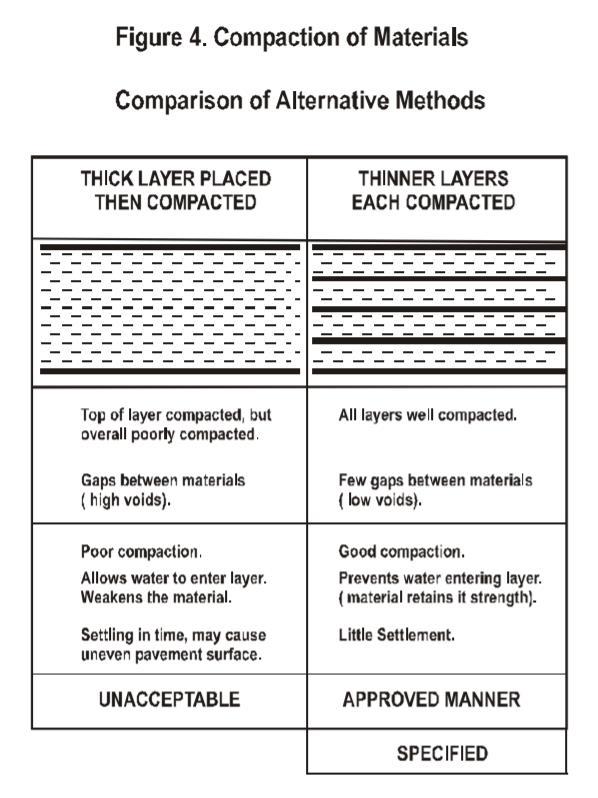
The subgrade is the layer of embankment immediately below the pavement. This may be undisturbed local material or may be soil excavated elsewhere and placed as fill. In either case it must be prepared to give added strength.
All subgrade material must be free of vegetable matter. The material also needs to be of a type and moisture content that it can be compacted to form a stable layer. If the material in the subgrade level is found to be unsuitable, this must be excavated and replaced with suitable material, which should then be compacted.
The subgrade must be prepared over the full width of the embankment, including the shoulders. This is generally carried out in lengths of greater than 100 metres. In some cases, to maintain traffic, part width working may be necessary. If this is the case it is vital that the full width of the embankment meets the subgrade material and compaction requirements.
When the road is to be placed on existing material, this should be fully loosened to a depth of 150 mm below the subgrade level. Any lumps should be removed or broken up to be less than 50 mm in size.
The subgrade must be compacted uniformly by use of adequate and appropriate compaction equipment. The material should be at a moisture content close to optimum throughout the layer so that it can be compacted to produce a dense compacted layer. Generally, the compaction should begin at the outer edges of the embankment and by rolling in a longitudinal direction gradually progress towards the centre so that each section receives equal compaction.
Three compaction tests are required for each 1,000 square metres of subgrade. If the test results show that the density is less than that required, further compaction will be necessary. After which the density should be rechecked to ensure the required dry density has been achieved.
The surface of the finished subgrade must be to the required cross section with a tolerance of 20mm above or below the specified level at any point. Typically, the subgrade should be checked at not greater than 25m intervals, where necessary shorter lengths can be checked. There must be no depressions which could form water ponding areas in the subgrade.
The subgrade layer must be approved before the Contractor can start on the construction of the road pavement.
Before any shoulder fill is placed, all subgrade preparation and subgrade drainage work require to be completed. For the shoulder a compaction test must be carried out for every 500 square metres of finished layer.
Subgrade drains are constructed to ensure that water in the pavement, which would weaken the road, can drain away.
Subgrade drains should be extended to the edge of the embankment with drains on opposite sides of the road being staggered. In case of roads with minimal longitudinal fall it is often better to install subgrade drains longitudinally at the edge of the road pavement.
Subgrade drains should be excavated by hand in the prepared subgrade. The excavation should be filled with clean sand or gravel, which contains no vegetable matter, silt or clay. The backfill must be compacted by hand ramming and struck off level with, or slightly above, the finished subgrade level.
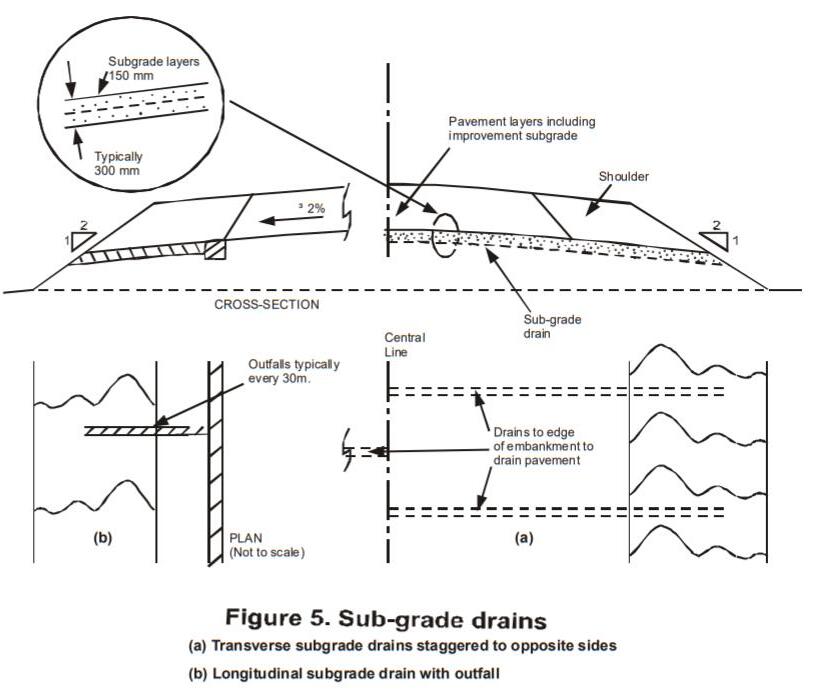
The finished backfill must be immediately covered with an approved separator material. The separator material is normally specified and will be woven rot proof fabric, geotextile membrane or perforated heavy duty polythene sheeting. The separator material should extend 150mm beyond the edges of the drain on all exposed faces. Any joints in the fabric should overlap by at least 150mm.
Materials over the drain should be placed by hand for at least 100mm above the separator membrane prior to rolling either the pavement or the shoulder materials.
On large contracts Contractors are required to plan for areas to process and stockpile pavement materials. Therefore, generally the preparation and storage of materials along the road should not be allowed. On small contracts, however, or when existing pavement materials are to be used in the new works this may be allowed.
A sample for each material proposed to be used, along with test results, must be submitted at least seven days before the material is used. The sample should be checked to see if the materials conform to the Specification. If the materials meet the requirements of the Specification, approval should be given by the Engineer for their use.
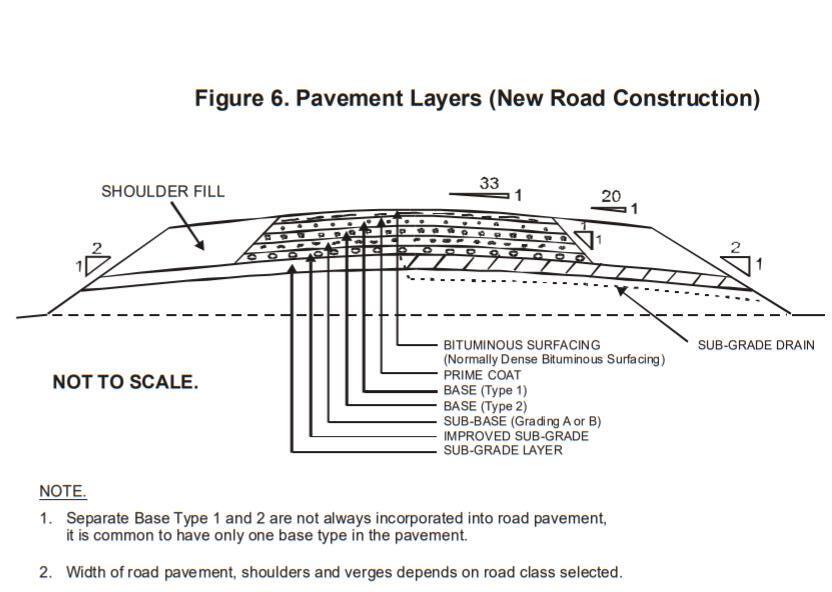
Improved Subgrade - Material for improved subgrade should be locally available material which is a natural or artificial mixture of sand or other mineral aggregate, free from vegetable matter. The material should not be greater than 5 mm and should not contain clay or soft particles.
Sub-Base - Sub base is the secondary load spreading layer of the pavement. The material should be a natural or artificial aggregate (or a combination) with no vegetable matter, soft particles or clay. The material requires to have varying sizes of material (well graded) with enough fine material so that it can be compacted to produce a close and tight surface texture. The coarse aggregates should not appear particularly flaky or elongated.
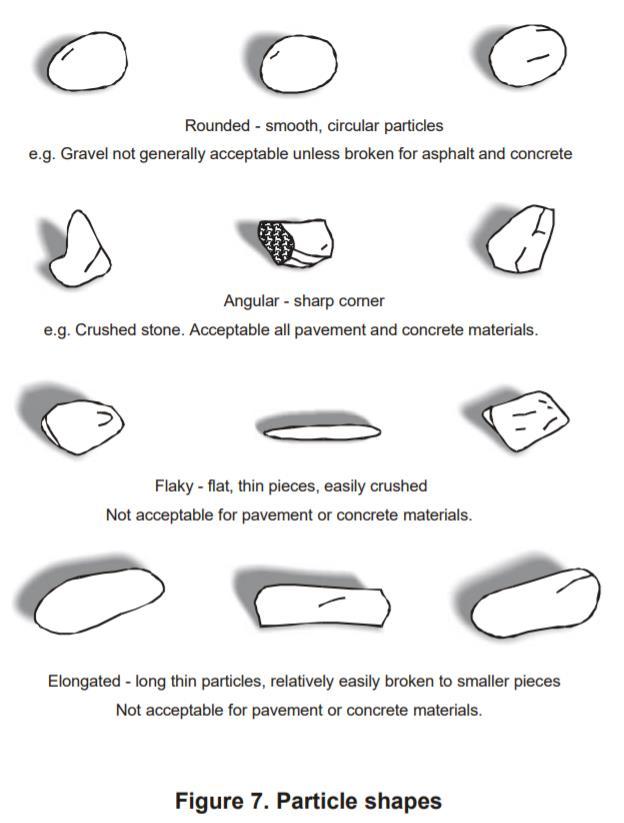
Aggregate Base - Aggregate base is the main load spreading layer. It should consist of hard pieces of rock, brick or gravel crushed to the required size, and a filler of sand or other fine mineral matter. The material must be graded, with enough fines so that it can be compacted to produce a close and tight surface texture. The materials should not contain clay and the coarse aggregate should not appear particularly flaky or elongated.
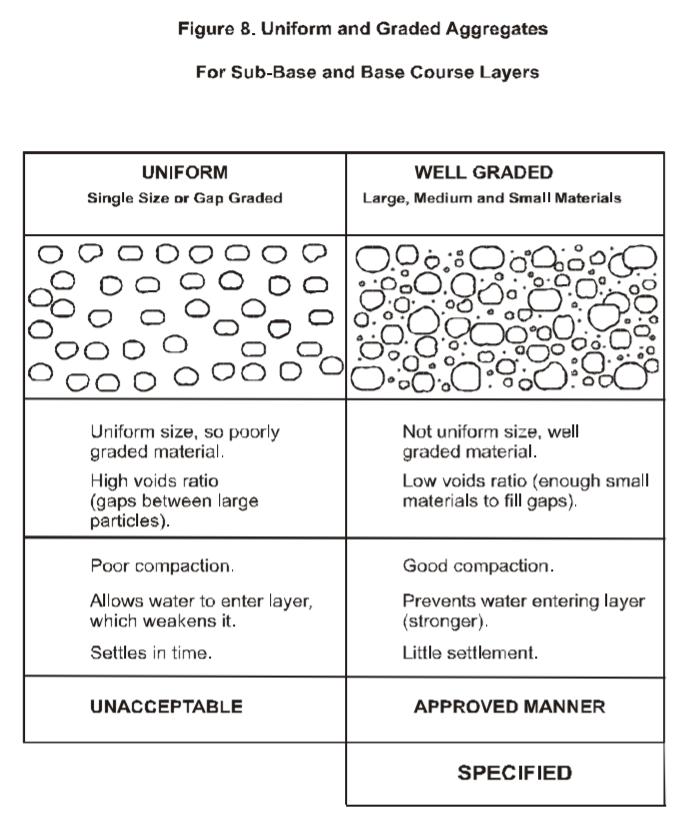
The grading and quality of the materials need to be monitored throughout the works. Samples of the materials brought to site should be regularly taken for testing to ensure that the materials continue to conform with the specification. If the tests indicate changes have occurred the contractor is to be notified of the noncompliance and the Engineer must be informed immediately.
Each layer needs to be inspected and be acceptable immediately prior to laying the next layer. If the previous layer is acceptable material should be spread in layers of nearly equal thickness up to 150mm un-compacted thickness. Where sand and aggregates are combined to meet the specified grading, care should be taken to prevent separation into fine and coarse parts (segregation). If separation occurs, this either needs to be corrected, or the material should be removed and replaced.
When the shoulder construction is the same as for the road, the material should be spread, for the full width of the pavement and shoulders at the same time.
The moisture content at the time of spreading requires to be appropriate to produce a dense compacted layer. This requires that the material contains a moisture content close to optimum throughout the layer. Additional water, or time to allow the pavement material to dry, prior to, or during compaction may be required. This is the contractor’s responsibility and no additional payment be made.
After spreading, each layer requires to be compacted with suitable and adequate compaction equipment. Rolling should begin from the outer edge of the placed material and gradually progress towards the centre, rolling in generally a longitudinal direction. However, on super-elevated curves, the rolling should begin at the low side and progress towards the high side.
Density of the compacted pavement layer must be determined by laboratory personnel in accordance with STP 6.2 with at least three tests being made for each 1,000 square metres. If the test results show that the achieved dry density is less than that required, further compaction is necessary. After further compaction the layer should be tested again to ensure the required density is achieved. Results of all the compaction tests should be kept on file as a permanent record.
The level and thickness of each pavement layer should be checked every 20 m. A pavement layer, which does not conform to the requirements for that layer thickness or tolerance of surface, must be corrected. This should be done by loosening the affected areas, adding or removing materials and re-rolling, mixing and watering, if
necessary. Once this has been done the area should be checked again to ensure it conforms to all the requirements for that pavement layer.
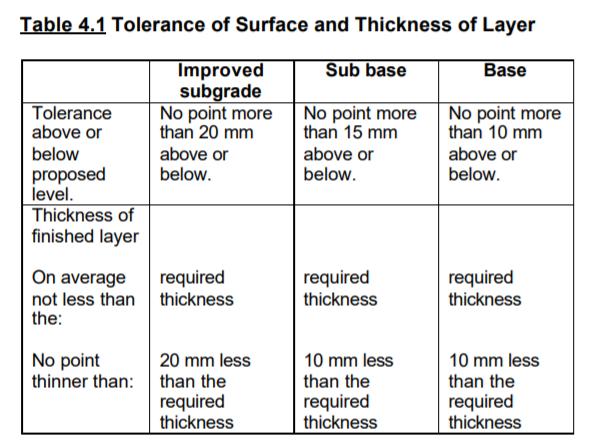
When the pavement is spread next to concrete kerbs or gutters, care must be taken not to damage them. If they are damaged due to the Contractor’s carelessness they should be removed and replaced at the Contractor’s expense.
At the start of constructing the improved sub grade and sub-base layers a field compaction trial should be carried out. This is to determine the optimum moisture content and the required number of passes of the compaction equipment to comply with the Specification. This trial should also determine the relationship between the loose and compacted thickness to ensure the material placed is adequately compacted to the specified density and the finished surface profile complies with the design level and permitted tolerances. Provided the method produces satisfactory results it should then be used for all subsequent compaction of that material. In this case provided the Contractor follows the agreed procedure, the frequency of checking the compacted density of the layer may be reduced with the Engineer’s approval.
Samples of all materials proposed to be use in the works, along with test results, should be received by the Engineer at least 14 days before the proposed use of materials. If the materials comply with the Specification, agreement should be given for test mixes or trials to be undertaken. Even if the initial bitumen sample provided complies with the Specification each consignment of bitumen delivered to site must be accompanied by a certificate. This should show the place of manufacture and the results of standard tests carried out on the batch of bitumen.
Before any bitumen is sprayed, or bituminous mixtures are placed, the road surface requires to be inspected. Any areas of base course, which appear broken or loose should be removed. Either the full depth of the base course requires to be reworked, or a bituminous rectifying layer should be placed and thoroughly rolled until it conforms to the surrounding surface. The surface must also be cleaned immediately before any material is sprayed or placed. Bituminous materials should generally be placed only when the surface is dry and when rain does not appear imminent.
The bitumen should only be utilised at the temperature range in table below:
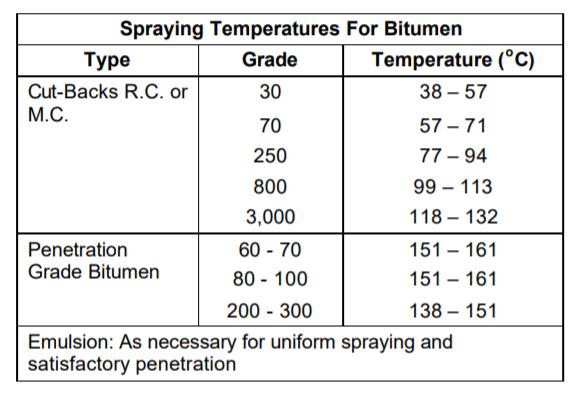
A bituminous prime coat is a thin layer of bitumen sprayed on to a prepared road base. Either MC 30 or MC 70 cut back bitumen should be used, which should be sprayed within the temperature range. The prime coat will normally be sprayed from a spray bar at the rear of a bitumen distributor, at the rate given in the Contract Documents. Alternatively, the rate can be directed by the Engineer.
It is important that the entire surface is uniformly covered and so prior to starting any spraying the nozzles in the spray bar need to be checked to ensure they are working. Also, the spray bar should be at the correct height, h, and be parallel to the road surface so that each point of the road is sprayed from three separate jets. As an alternative and only generally on small projects the contractor can propose equipment and methods (including labour intensive methods).
No further bituminous layers must be applied until the prime coat has dried, this should occur within 48 hours.
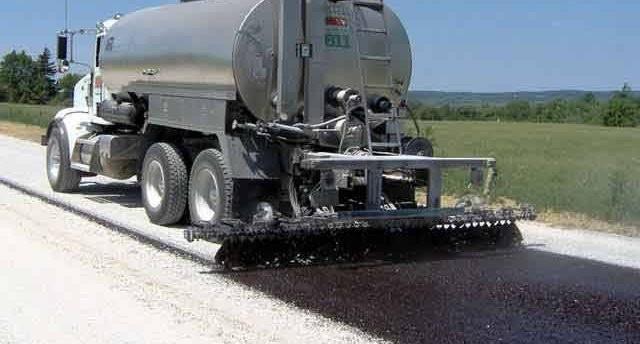

A tack coat is normally applied to make the road surface sticky prior to dense bituminous surfacing or carpeting being placed. To ensure this occurs the tack coat
should therefore only be sprayed immediately before the carpeting is placed.
The tack coat will normally be applied by bitumen distributor unless labour intensive methods are agreed. The tack coat material requires to be uniformly distributed over the surface without streaking.
The bitumen used should either be cut back bitumen RC 30, RC 70, or rapid setting emulsion and this should be sprayed within the temperature range.
A primer seal consists of pea gravel material rolled into a cut back bitumen, which has been sprayed on to a prepared surface. The Pea gravel should be graded so that 100% of the material falls within the size range of 2.4 mm to 6.3 mm. The Pea-gravel must be free from any organic matter or clay and should be completely dust free. The procedure to be followed is:
• Cut back bitumen is sprayed on the prepared surface.
• Screened pea gravel aggregate spread to provide a dense uniform cover one stone thick.
• The aggregate to be rolled into the bitumen immediately using a rubber tyre roller for at least 4 passes before the road is opened to traffic.
This surfacing consists of nominal single size aggregate rolled into a bitumen layer, which has been sprayed on to a prepared surface. This is often known as a single surface dressing. The procedure can be repeated using a smaller single size stone rolled into the gaps to promote a good interlock between the layers, this is known as a double surface dressing.
The aggregate requires to be hard, crushed stone or crushed gravel of uniform quality. This should be free from any dust and contain no vegetable matter and should not be flaky or elongated. The aggregate must not be used until it appears dry as water prevents bitumen adhering effectively to the aggregate.
The rates of bitumen and aggregates may be specified in the contract documents, but these are normally established from site trials. The bitumen layer will generally
be sprayed using a bitumen distributor using, but for small areas hand spraying equipment is used. The bitumen should generally be either RC 800 or RC 3000 cut back bitumen or rapid setting emulsion at the appropriate temperature.
Immediately after the bitumen is sprayed the aggregate should be spread uniformly using a mechanical aggregate spreader. At this stage the surface requires to be inspected and further aggregate should be placed in any insufficiently covered areas by using the spreader or covering by hand methods.
Immediately after spreading, the aggregate requires to be rolled, preferably with one or more pneumatic tyre rollers. The rolling must be continued, for as long as is necessary to ensure the aggregate is firmly embedded into the bitumen. If tyre rollers are not available steel wheeled rollers may be permitted. However, in this case the finished surface must be checked to ensure that the aggregate is not crushed and is being fully embedded into the bitumen.
A dense Bituminous Surfacing consists of graded aggregates, including a filler, coated with bitumen. The material is laid hot and is compacted to form a dense impervious layer. The surfacing can either form the road surface or a seal coat can be laid on the asphalt.
On large contracts the bituminous materials are manufactured, transported and placed by plant. On smaller contracts, more labour-intensive methods are generally used. In either case due to the high cost of the materials, it is vital that the works are undertaken to the specified quality. Therefore, a job mix should be undertaken and the asphalt should be to the thickness and compaction standards as specified.
12.6.1
Samples of materials proposed to be used with their test results have to be received by the Engineer at least 14 days before the materials’ proposed use. Full requirements for materials are given within the Specification. If the materials meet the Specification approval should be given (by the Engineer) for the contractor to manufacture job mixes. The following points, which relate to materials, should be noted when considering whether materials are acceptable:
• Crushed stone or crushed gravel should be used for the coarse aggregate, that fraction larger than 5 mm. The aggregate should be free from vegetable matter and the particles should not be soft, flaky or elongated.
• The fine aggregate, that fraction smaller than 5mm, should consist of natural sand, stone screenings, or a combination of both. The aggregate should consist of clean angular particles, with the material being free from vegetable matter, soft particles and dust.
• In order to achieve the specified grading mineral filler may be required. This should be either a natural rock dust or a fine mineral matter (Portland cement or hydrated lime) and should be dry and free from lumps.
The quality of the materials needs to be regularly checked throughout the duration of the contract works. If there appears to be any deterioration the Contractor and the Engineer should be notified and samples of the materials should be taken and sent for testing.
After approval of the materials the contractor must design a job mix formula. To ensure the road surfacing performs satisfactorily the mix must be designed to have a low percentage of air voids and good fatigue behaviour. To ensure these characteristics are achieved it is vital that the proportions are established and this occurs with the production of the job mix. The formula must provide details of the mixing proportions of the various constituents, the percentage of aggregate passing each sieve size and the percentage of the bitumen which will be used.
The mix formula should also provide the methods of mixing and heating of the materials (including means of temperature control) and the means of transportation, laying and compaction. A temperature for the emptying of the mixture from the mixer, and a temperature at which the mixture is to be delivered on the road are also required.
All the above information must be provided to the Engineer who, if satisfied, will approve the job mix. After approval the Contractor is required to lay trial sections of surfacing for each formula to demonstrate that the works will be to the specified quality.
Generally, no contract surfacing works may be carried out until the mix formula has been approved and the trial sections have been satisfactorily completed. However, the Engineer may allow the manufacture of asphalt to start on small contracts (this must be approved in writing) in which case, the temperature and grading of the materials requires to be closely monitored. When a mix formula has been approved it is vital that all the asphalt conforms to the formula within the following tolerances:
Passing sieves 10 mm and larger……………………………………………. ± 8%
Passing sieves between 10 mm and 0.075 mm………… . ± 5%
Passing 0.075 mm sieve ………………………………………………….… ± 1%
Bitumen content (single test result) …………………………………….… ± 0.50%
Bitumen content (three consecutive test results) ………………………… ± 0.40%
Temperature of mixture when emptied from mixer ………………………. ± 15 °C
Temperature of mixture at delivery on road ………………………………. ± 15 °C
Each day three samples of the asphalt must be taken and tested (Marshall specimens). Also, the temperature when emptied from the mixer and when delivered to the road should be continuously monitored. Samples should also be taken daily and tested in accordance with STP 10.4 (Extraction of bitumen) to determine the composition and the percentage of bitumen included in the mix, as well as, gradation of the mix. When unsatisfactory results are obtained the Contractor must take immediate corrective action, if he does not, the Engineer must be informed.
The Engineer should also be informed if any changes in the materials occur and he may require a new mix formula and further trials to be undertaken.
The Contractor must supply sufficient qualified personnel to ensure the correct operation of the asphalt plant and the laying of the material. All the equipment proposed to be used by the Contractor requires to be in good condition and to be operated by competent and experienced operatives. The Contractor must maintain records of batch numbers and the areas that are asphalt paved. This means if results later indicate that the asphalt did not comply with the Specification its location can be identified and if required the material can be removed.
Trucks for hauling the asphalt must have clean and smooth metal beds. The beds should be sprayed with limited amounts of soapy water, thinned fuel oil, paraffin oil, or lime solution to prevent the mixture from sticking to the beds. Each truckload should be covered with canvas, or other suitable covering, to protect the asphalt from the weather.
Self powered pavers, capable of spreading and finishing to the required cross section will normally be used. The paver must be able to place the thickness of material required per square metre. Immediately the mixture has been spread and struck off, the surface requires to be checked and any inequalities adjusted. In irregular sections
or small areas where it is impractical to use a paver, hand methods can be used, subject to the approval of the Engineer.
(ii)
Due to the quantity produced by asphalt plants and the requirement to achieve satisfactory compaction a number of rollers are required. The mixture must be thoroughly compacted as soon as the material will support a roller without undue displacement or cracking. Sufficient rollers should be used so as to ensure that the required degree of compaction of the asphalt mat is achieved before the temperature falls below 107°C.
The first rolling including all joints and edges, and the final rolling should be done with a steel wheeled tandem roller, which must be able to operate with and without vibration.
For initial rolling, the drive roll should be nearest the paver and the speed of the roller should not exceed 4 km/hr. The second or intermediate rolling, should be done with pneumatic tyre rollers (PTR), in this case the speed should not exceed 6 km/hr.
Rolling should generally start longitudinally at the sides and proceed toward the centre of the pavement. Successive passes of the roller should overlap by at least one half of the width of the roller and alternative passes should not stop at the same point.
The wheels of rollers must be kept properly moistened with sufficient water to prevent adhesion of the mixture to the roller. However, excess use of water is to be avoided as this will cool the asphalt mat. Also, at no time should rollers be allowed to stand on newly laid material, as the surface may deform if this is allowed to occur.
For manual methods temperature control is particularly important and a thermometer should be located at each mixing unit. The temperature of the bitumen, mineral aggregates and bituminous mixture should comply with the job mix formula (if applicable), or should be within the limits stated below.
The 80/100 penetration grade bitumen normally used can be poured (albeit slowly) into a locally produced wood fired boiler. Once the boiler is approximately 30% full the wood in the firebox should be ignited.
Temperature control at the boiler is critical to prevent the bitumen being over heated (cooked). When the thermometer within the mass of bitumen reaches 150°C the firebox should be emptied or the fire extinguished. The residual heat within the tar boiler will continue to heat the bitumen. The temperature should be monitored and once it starts to fall and reaches 155°C the fire box should be re-ignited as the temperature will soon fall below 150°C. The heating operation should be repeated as many times as necessary to maintain the temperature in the appropriate range. With experience an operator can soon judge the amount of firewood required to achieve and maintain the specified temperatures. The temperature of the bitumen must not be allowed to exceed 163°C. Any bitumen heated above this temperature is to be discarded and the tar boiler refilled with new bitumen and the heating process started again. Such ‘cooked’ bitumen may, with the Engineer’s approval, be subsequently used to make prime coat.
Gauging (measuring) boxes should be constructed for each type of aggregate. These must be to the required size to deliver for each batch the correct volume of aggregate to comply with the approved job mix.
The gauging boxes should be emptied into rectangular steel pans, which have handles at each corner. These pans should be heated on top of a metal frame under which heating is provided by firewood and sawdust. The aggregates should be continually raked to ensure thorough mixing and even heating. The temperature of the aggregate must reach above 163°C, after which the pan should be transferred to an unheated frame. The raking should then continue until the aggregate temperature has reduced to the maximum mixing temperature permitted (163°C).
At this stage the heated bitumen should be drawn off from the boiler, (into gauge tins) and added to the aggregate in the pan on the unheated frame. As the two ingredients are at approximately the same temperature there is no risk of fire.
The aggregate and bitumen should then be thoroughly mixed within the range of 135°C to 163°C with the temperature for each batch being recorded and later submitted by the Contractor
(iii)
When the mixing is satisfactorily completed, the pan should be carried to the adjacent work for placing. The depth of the finished surfacing can be controlled using mild steel angles as side shutters. For example, an angle of 65 × 65 mm with an uncompacted asphalt depth of 65 mm being placed, is required to achieve a
compacted 50 mm surfacing depth. The cross-fall or super elevation should be controlled using 65 × 6 mm steel plate at intermediate points between the edge and the crown of the road.
In manual methods as the speed of asphalt placement is likely to be less in many cases only one roller is used. If the Contractor is using a 3.5-ton vibrating roller the initial pass should be with NO vibration. After this initial roll the side and intermediate shutters should then be moved to their next location while the roller, with vibration ON, completes the compaction process.
Trials will be required to assess the number of passes to achieve full compaction for each type of roller. Compaction is generally achieved when all roller marks have been removed. It is vital that the asphalt is rolled immediately after placing when the mat can withstand the rolling and full compaction must be achieved before the temperature drops below 107°C.
If more than one layer of asphalt is laid the longitudinal joints in successive courses should be staggered by a minimum of 250 mm, with the joint in the top course being in the centre of the road. Transverse joints should be staggered by a minimum of 1 m.
Before placing mixtures against them, all contact surfaces of kerbs, gutters, headers, manholes etc. should be given a thin uniform coating of hot bitumen. In locations where the use of rollers adjacent to these fixtures is not possible hot hand or mechanical tampers, which will give an equivalent compaction to rollers, should be used.
After final rolling full depth samples should be cut for each 50m of completed surfacing to check the density and the thickness of the layer by an approved coring machine. Where samples have been taken, fresh material must be placed, and thoroughly compacted. The density shall not be less than 97% of the Marshall density and the thickness of any individual core shall not be less than the specified thickness by more than 5 mm. The average thickness of the mat shall not be less than the specified thickness.
After compaction the surface of the road should appear to be impervious and to be free from any dragging cracks or other surface blemishes. The surface should also be checked at intervals not exceeding 10 m by a 3m straight edge and a crown template. The variation between two contacts should not exceed 5 millimetres.
Any asphalt area that is defective, including any areas where petroleum products have been dropped or spilled, must be removed and replaced with fresh hot mixture. This asphalt requires to be compacted immediately and re-tested as appropriate.
Lastly, ideally sections of the newly laid surfacing should be protected from traffic until the mixture has cooled to ambient air temperature (about 6 hours). However, in many cases it will not be possible to allow all this time to elapse.
A seal coat consists of generally fine graded aggregates coated with bitumen. This is placed on newly laid bituminous carpeting or an existing bituminous surface, to seal the surface. However, if well graded premixes, which have been properly controlled, have been placed a seal coat may not be required. The aggregates should consist of 6.3mm downgraded clean pea gravel free from any vegetable matter. Where required to achieve the grading the aggregate should be mixed with clean natural sand, which is non-plastic, and also contains no vegetable matter. A similar procedure to that detailed in Section 12.6 should be followed. The Contractor must initially submit samples and produce a job mix formula. Thereafter the construction should follow the methods detailed in the relevant sections above. The completed surfacing after compaction should appear to be close and tight.
13.1. Preparation of base
W.B.M. base
As base material of W.B.M. Road; stone ballast, concrete 10-15cm layer are used. For bonding between concrete slab & W.B.M. used 1:2 cement wash on W.B.M.
Granular medium material layer
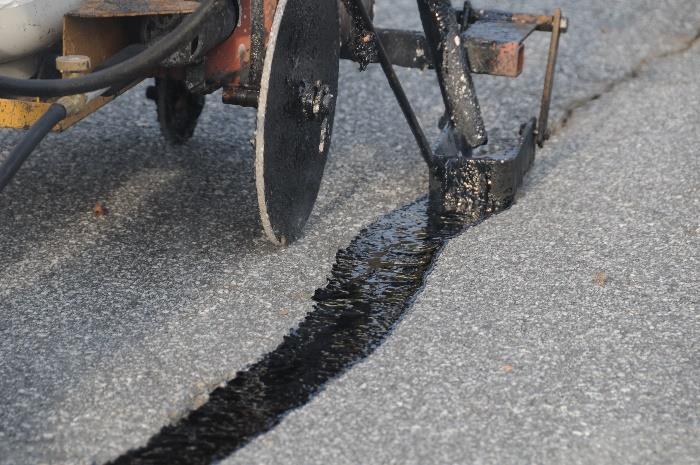

10-15cm composite layer of sand, moorum, bajriare used for better drainage facilities
Preparation of The Existing Base Course Layer
The existing surface is prepared by removing the pot holes or rust if any. The irregularities are filled in with premix chippings at least a week before laying surface course. If the existing pavement is extremely way, a bituminous levelling course of adequate thickness is provided to lay a bituminous concrete surface course on a binder course instead of directly laying it on a WBM.
13.2. Application of Tack Coat
It is desirable to lay AC layer over a bituminous base or binder course. A tack coat of bitumen is applied at 6.0 to 7.5 kg per 10 sq. Area, this quantity may be increased to 7.5 to 10 kg for non-bituminous base.
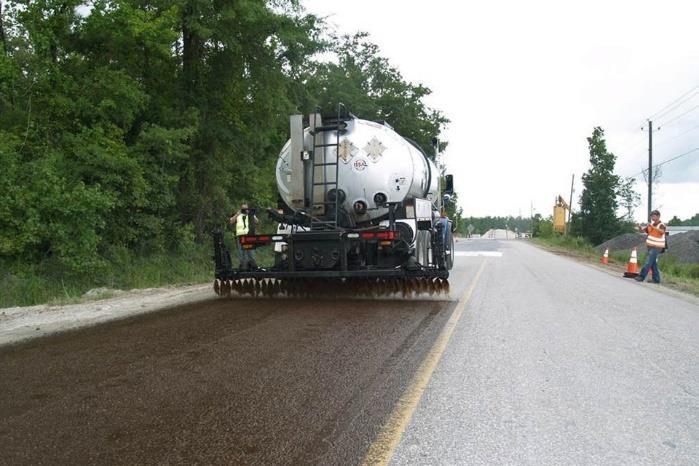
of Premix
The premix is prepared in a hot mix plant of a required capacity with the desired quality control. The bitumen may be heated up to 150 –177°C and the aggregate temperature should not differ by over 14°C from the binder temperature.
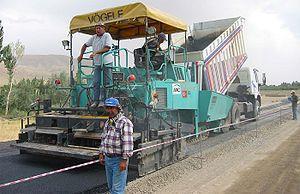

The hot mixed material is collected from the mixture by the transporters, carried to the location is spread by a mechanical paver at a temperature of 121 to 163°C. the camber and the thickness of the layer are accurately verified.
The control of the temperatures during the mixing and the compaction are of great significance in the strength of the resulting pavement structure.
A mix after it is placed on the base course is thoroughly compacted by rolling at a speed not more than 5km per hour.
The initial or break down rolling is done by 8 to 12 tonnes roller and the intermediate rolling is done with a fixed wheel pneumatic roller of 15 to 30 tonnes having a tyre pressure of 7kg per sq.cm. the wheels of the roller are kept damp with water.
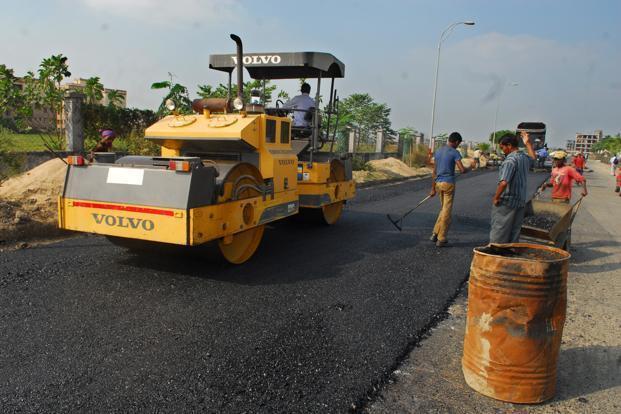
The number of passes required depends on the thickness of the layer. In warm weather rolling on the next day, helps to increase the
density if the initial rolling was not adequate. The final rolling or finishing is done by 8 to 10 tonne tandem roller.
construction
The routine checks are carried out at site to ensure the quality of the resulting pavement mixture and the pavement surface.
Periodical checks are made for
a) Aggregate grading
b) Grade of bitumen
c) Temperature of aggregate
d) Temperature of paving mix during mixing and compaction
At least one sample for every 100 tonnes of the mix discharged by the hot mix plant is collected and tested for above requirements. Marshall tests are also conducted. For every 100 sq.m of the compacted surface, one test of the field density is conducted to check whether it is at least 95% of the density obtained in the laboratory. The variation in the thickness allowed is 6mm per 4.5m length of construction
13.6. Finished surface:
The AC surface should be checked by a 3.0 m straight edge. The longitudinal undulations should not exceed 8.0 mm and the number of undulations higher than 6.0 mm should not exceed 10 in a length of 300 m. The cross-traffic profile should not have undulations exceeding 4.0mm.


Road is open to traffic as soon as bitumen gets cooled to its surrounding temperature.
The under taken project by PWD was for the renewal of selected parts of the NH9 pavement. National Highway 9 (NH 9) is a National Highway in India in east-west direction. It starts at Malaut in Punjab and ends at Askot in Pithoragarh district in Uttarakhand. It passes through the states of Punjab, Haryana, Delhi, Uttar Pradesh and Uttarakhand. After renumbering of all national highways by National Highway Authority of India in 2010, the current NH 9 was formed by merging segments of five separate national highways in 2010; these were Old NH 10 (FazilkaDelhi section), Old NH 24 (Delhi-Rampur section), Old NH 87 (RampurRudrapur section), Old NH 74 (Rudrapur-Sitarganj-Khatima section) and Old NH 125 (Tanakpur-Pithoragarh section).
This is a state highway road where the traffic is heavy, therefore for the convenience of travellers and for the economical & social growth of the people of both the cities the existing asphalt pavement was renewed.
Considering the traffic, economy and purpose of the road its width was taken as 14m. And the proper investigation was done by PWD Assistant Engineers & Junior Engineers for the quality control and better implementation of work.